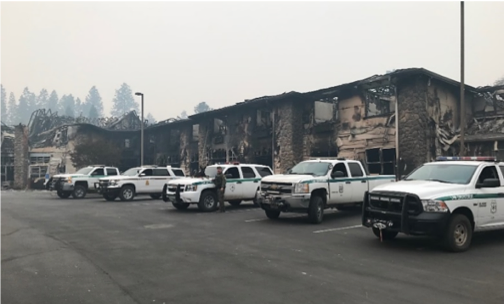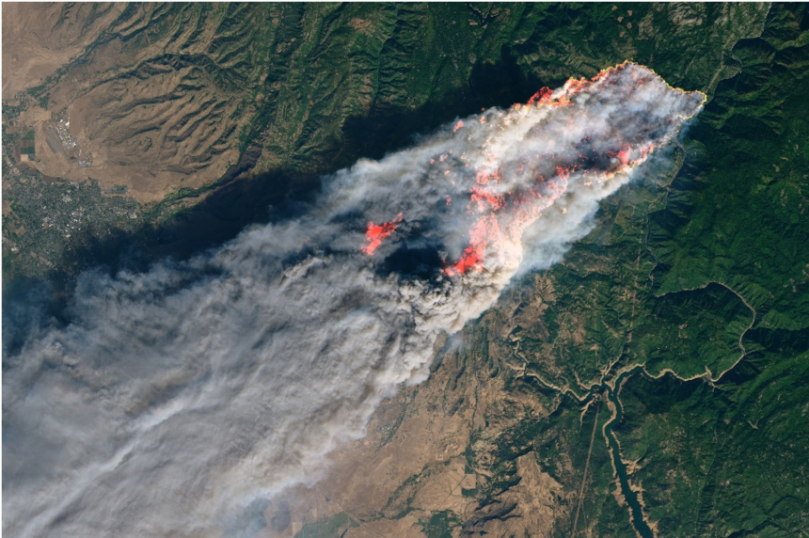California’s autumn 2018 Camp Fire wildfire was the deadliest and most destructive fire in the state’s history and the deadliest wildfire in the US in the past century.1,2 Eighty-five people have been confirmed dead with over 153,336 acres burned; the 2017 Tubbs wildfire, the second most destructive fire in the state’s history, burned through 36,807 acres.3 For a sense of scale, all of New York City covers about 194,000 acres. During the summer of 2018, here in Washington state we saw many days of unhealthy air quality and smoky skies due to the wildfires originating from British Columbia, Canada.4 As global warming and climate change increase the number and size of wildfires, we need better technology to limit the effects of wildfires on human communities.5

How do we push for better technology for mitigating the effects of wildfires? In April 2017, the Environmental Protection Agency (EPA), in collaboration with seven federal partners, launched the Wildland Fire Sensors Challenge.6 This challenge called for competitors to propose a sensor system that would allow firefighters, first responders, and authorities to continuously and easily measure wildfire smoke exposure. Furthermore, this type of improved wildland fire sensing technology will allow scientists to improve air quality forecast models and wildfire occurrence models.

Measuring Air Pollution
Wildland fires result in significant smoke air pollution, creating health issues for first responders and nearby communities. During a wildland fire, immobile air pollution stations that are about the size of a trailer are used to detect and measure the concentration of air pollutants. It is difficult to rapidly deploy these stations in the event of a wildland fire. Their instrumentation and hardware are large and expensive, and the systems are complex to install, integrate, and maintain. As a result, the number of these stations and the availability of pollution data is limited.7

Wildfire smoke has been a huge public health issue on the west coast. As I mentioned, Washington state had a lot of poor air quality last summer due to Canadian wildfires.4 According to the Washington State Department of Natural Resources, Washington has 2.7 million acres of unhealthy forests vulnerable to wildland fires in Eastern Washington alone.8 Better air pollution sensors are a significant part of the solution to reduce the impacts and effects of inevitable wildfires.
The EPA and its federal partners launched the Wildland Fire Sensors Challenge to develop the emerging technology in air sensors. Scientists and engineers were encouraged to enter the challenge with their new devices, which had to include the following design parameters:
- Lightweight and portable
- Simple to operate
- Battery or self-powered
- Provide highly accurate measurements
Moreover, the devices were to transmit data wirelessly, include a compact microprocessor, self-operate for 15 days, and allow reporting of air pollution continuously and in real-time, while withstanding the smoldering heat and harsh field conditions of being used during a fire.6 The challenge specifically focused on measuring carbon monoxide (CO), ozone (O3), carbon dioxide (CO2) and particulate matter equal to or less than 2.5 micrometers in diameter (abbreviated as PM2.5). These pollutants are important because of their adverse interactions with the environment and human health. Measuring PM2.5 during a wildfire event is particularly important because PM2.5 can penetrate deep into the membranes of the lungs, causing damage.7 This is not as small as nanoscale — 2.5 micrometers is 2,500 nanometers — but nanoscale (or ultra-fine) pollution from smoke also has potential health effects.9
NASA, one of the agency partners for the Challenge, is interested in the improved data collection of these air sensing devices in order to integrate satellites for faster wildfire detection, measuring fire intensity, and presence of trace gases and particulates. Ultimately, the improved devices will allow authorities to inform residents sooner and dispatch first responders earlier. Moreover, with the robust, real-time, and continuous data reporting, firefighters and first responders can prepare appropriately for different kinds of wildland fires.6
The Challenge Winners
In September 2018, the winners of the challenge were announced at the Air Sensors International Conference in Oakland, California. The winners had all proposed and submitted field-deployable prototypes that passed initial rigorous laboratory tests.10 The first-place winners of the EPA Wildland Fire Sensors Challenge were SenSevere/Sensit Technologies of Pittsburgh, Pennsylvania, in partnership with Carnegie Mellon University, who received $35,000. The second-place winners were Thingy LLC of Bellevue, Wash., who received $25,000. Honorable mention went to Kunak Technologies® of Pamplona, Spain.11

The winning SenSevere/Sensit Technologies air pollution sensor included a solar-powered battery that can last for three weeks on one charge. The team is currently planning to deploy some of their units alongside existing air quality monitoring stations to ensure the units can report similar and accurate results by conducting comparative studies. The team will begin large-scale manufacturing once they produce reliable results.
Stimulating Technology Development
The EPA Wildland Fire Sensors Challenge has been a successful collaboration in stimulating technology development in improved air pollution detection and measurement detection devices.10 Wildfire smoke pollution is a serious concern for the environment and human health. Existing air quality monitoring stations include hardware that’s heavy, expensive, and difficult to operate and maintain. These stations are also immobile, so they cannot be transported in close proximity to a wildland fire event. The Wildland Fire Sensors Challenge has been instrumental in developing easily and rapidly deployable air pollution sensors that are on their way to being manufactured for use at future wildland fire events. Additionally, these miniaturized devices transmit data wirelessly, continuously, and in real-time. This new technology will improve response to wildfires, ultimately reducing the effects of wildland fire smoke exposure.6
REFERENCES
- CalFire. Top 20 Most Destructive California Wildfires. 2019.
- De La Garza, A. Northern California’s Camp Fire Is 100% Contained. Time, Nov 25, 2018.
- Lam, K. Camp Fire: Death toll from California’s deadliest wildfire drops to 85. USA Today. Dec 3, 2018.
- Paul, C. After wildfires, Washington’s outdoors industry braces for smoky summers ahead. The Seattle Times. Sept 3, 2018.
- Schoennagel, T., et al. Adapt to more wildfire in western North American forests as climate changes. PNAS. 2017, 114(18), 4582–4590. DOI: 10.1073/pnas.1617464114
- Environmental Protection Agency (EPA). Wildland Fire Sensors Challenge. 2017.
- EPA. Advancing Sensor Technology to Monitor Wildfires. 2018.
- Washington State Department of Natural Resources, 20-Year Forest Health Strategic Plan: Eastern Washington (n.d.)
- Leonard, S. et al. Particle size-dependent radical generation from wildland fire smoke. Toxicology, 2007, 236 (1-2) 103-113. DOI: 10.1016/j.tox.2007.04.008
- EPA. Winners of the Wildland Fire Sensors Challenge Develop Air Monitoring System Prototypes. 2018.
- EPA. Pittsburgh, Pa. group wins contest for developing air quality monitors in Wildland Fire Sensors Challenge. Sept 13, 2018
